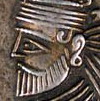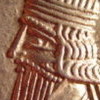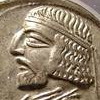From Parthia to Gothica
The Moving of King David's Throne
by Cam Rea
Develops a theme of Steven Collins. The Parthians were Scythian-Israelites. Parthians overthrown by Sassanian Persians flee to Armenia and from there to Scythia. Parthians become Goths and move into Dacia overturning the Roman Empire. Parthian-Goths move westward. Parthian Arsacid Royal House descended from the Clan of King David.
From
Parthia
to Gothica

by Cam Rea
Strive not with a man without cause, if he hath done thee no harm" (Proverbs 3;30).
And the channels of the sea appeared, the foundations of the world were discovered, at the rebuking of the LORD, at the blast of the breath of his nostrils.
He sent from above, he took me; he drew me out of many waters: (2-Samuel 22;16-17).
Put away from thee a froward mouth, and perverse lips put far from thee" (Proverbs 4;24)
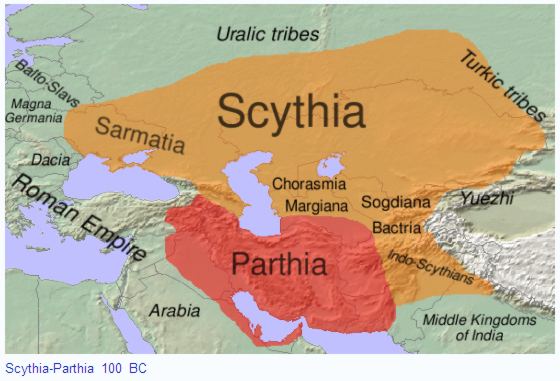
Parthian Monarchs

Artabanes
|
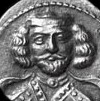
|
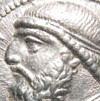
Mithridates
|
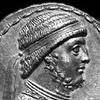
Mithridates II
|
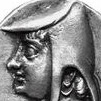
Arsaces I
|
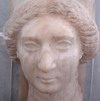
Queen Musa
Consort of Phraates IV
|
From Parthia to Gothica
Brit-Am Preamble
The Parthians were in effect a group of Scythians centered around the Arsacid Ruling House. The Parthians ruled over the Persian Empire until they were defeated by the native Persian Sassanian clan. In "The Tribes"
we identified the Parthians with Israelites. Steven Collins in several works also identifies the Parthians as Israelites and deals with them at length. The points raised by Steven Collins are different to those we relied upon but complementary to them. Brit-Am in "The Tribes" pointed to connections between the Parthians and Goths while Steven Collins believed that the Parthians became Goths and went westward with them. The article below by Cam Rea should be considered as developing a theme from the works of Steven Collins.
From Parthia to Gothica
The moving of King Davids Throne.
By Cam Rea
The Setting Stage
Sometime around 208 A.D. a non-Parthian Persian man by the name of Ardashir I rose to power due to the weakened state of Parthia, and began with taking the throne of Balkh a vassal state within the Parthia from his brother in 208 A.D. This very act began his rise to power. Ardashir I than took advantage by taking the provinces of Kerman, Isfahan, and Susiana because Parthias weakened state due to the wars with Rome.[i] This very act by Ardashir I would not go unnoticed because by 216 A.D. Artabanus IV King of Parthian had to do something, or face losing everything. Artabanus IV began first by defeating the Romans near Nisibis. Parthia won a great victory over the Romans in 217 A.D. near the town of Nisibis in which the Roman commander Macrinus was now the new acting Emperor due to the murder of Caracalla who started the war with Parthia to begin with. Even though the Parthians defeated the Romans, Parthia had received its very own death blow. Even though Rome was wounded, and would continue on for sometime, Parthia lay in the sand bleeding, and the vultures where coming down to take their pick, and Ardashir I was one of them.1
After the war with Rome Parthia made out good in the peace treaty. Macrinus emperor of Rome had to pay 200 million sesterces to Artabanus IV. Artabanus IV made a good deal, but it was in money and not men. Due to the wars with Rome Parthia had lost much of the manpower that was loyal to Parthia and to the Arsacid throne.[ii]
Then Artabanus IV in 224 A.D. turned what was left of his forces and their morale towards Ardashir, and his dreams of a centralized Persian Empire. Artabanus IV, and Ardashir I, clashed swords three times in which Ardashir won all three battles, and at Hormizdeghan which was the third battle between the two would result in the death of Artabanus IV. After the battle Ardashir had the head of Artabanus hung in the temple of Anahita which is near Persepolis.[iii] After the battle Ardashir put his full weight into conquering the western portion of the Parthian Empire, and by 226 A.D. Ardashir I was the sole ruler of Persia, ending the 400 year Arsacid rule, and establishing the 400 year rule of the Sassanid Empire, and crowing himself with the title Shahanshah or King of Kings at Ctesiphon. [iv]
Parthian Expulsion and Migration
Parthia now defeated and defunct had to look west for survival. They would find this rest and comfort in the land of Armenia. Armenia was under Arsacid rule at the time Parthia fell. The Parthian families and princes could thus flee into the arms of their cousins without a fight. For if any Parthian prince or royalty of that matter stayed behind, then death would be brought to them.[v]
The situation in Parthia was a bloody mess for anyone that was in relation by blood or by friendship within the boarders, but even outside the boarders their was no rest. Armenia and their Arsacid King Khosrov also known as (Trdat II) must now prepare to face the coming Persian armies. Ardashir wanted Armenia for it use to be apart of Persian Empire, and also their was a Arsacid sitting on the throne which posses as a treat to Ardashirs throne in his newly founded Persian Empire.[vi]
King Khosrov of Armenia opened the gates of the Caucasus to his nation, and allowed their Scythian kin to enter as well as opening his doors to the Romans and receiving their support. He allowed in the refuges from the former lands of Parthia which included the sons of the slain Parthian king Artabanus IV.
In 226 Ardashir and his armies marched towards Armenia only to be met by Roman and Scythian forces and what was left of Parthia too. For two years Persia smashed this coalition in a series of battles, and bribed others to stop fighting. Because of this Roman and Scythia grew tired and left the scene. The Kushan King could do no more and left. Armenia was now left alone to continue the fight and for nearly 12 years Armenia fought alone against the mighty Persian army of Ardashir and won.[vii]
Then in 252 A.D. the Sassanian Shapur I had King Khosrov assassinated and then conquered Armenia. This resulted in a new war with Rome. With the death of King Khosrov not all hope was lost with this branch of the Arsacid dynasty as his son was smuggled out of Armenia and was educated in Rome for the next 20 years. His name was Tiridates.[viii]
With Parthia gone and Armenia conquered, what was left? What was left was the continuation of the Arsacid dynasty. The infant Tiridates was smuggled into Rome and was spared from the sword to later rule Armenia again, and make it the first Christian Kingdom in the east. The Arsacid dynasty that came from Parthia that fled to Armenia eventually went north through the Caucasus to escape the oncoming Persians.
So were did the Parthians settle down at and with who? Rawlinson gives us a hint, and cites the classical historians of Strabo, Justin, and Arrian in stating:
"The manner of the Parthians had, they tell us, much that was Scythic in them. Their language was half-Scythic, half-Median. They armed themselves in the Scythian fashion. They were, in fact, Scyths in descent, in habits, in character".[ix]
The statement above shows where we can find the Parthian refugees that escaped the Persian slaughter. We can find them around the Black Sea region, and living among the group called the Scythians.
But why did not the Parthians stay in Armenia to fight it out completely? They did for a short time but I think Steven M. Collins gives the best answer for this. In his book "Israels Tribes Today" Mr. Collins states:
"There is no way that mountainous Armenia, with limited arable soil, could have supported the great mass of Parthian refugees seeking a new homeland".[x]
The Parthians had to move into new lands with recognizable kin in order to survive. Also they needed vast land, and rich soil that is found in the Black Sea region to rebuild their population, and to rebuild their army that was mostly made of Cavalry because of the short grass, and steep like environment. Scythia was an excellent place to graze horses and plan a future war with Rome.
Reuniting With Family
As a few decades passed the terms Parthian and Scythian are no longer heard, and become all but unrecognizable even to the Romans. The Romans called the Scythians Getae not knowing for sure who the Scythians were even before Parthia fell due to the fact that so many Barbaric tribes had been passing by and settling around Rome's eastern boarders.
Now that Parthia fell, and decades passed, the Parthian refugees intermingled with the Getae, or Gauthei, or Goths by whom the Romans called them. It seems that Americans of today have the same problem as the Romans then. Who is who, and what is their name again? But what is most interesting is the fact that the different groups that meet around the Black Sea region did not declare war upon one another! But, that is not to say they did not have their battles. They just did not go into full blown war. Instead it seems that they mingled amongst one another without finding fault. This is odd to most, but not too odd. The reason for the mingling is because they're all kin! The Goths, Getae, Germans etc.... are all kin![xi]
But before we go on I want to make a point about the word Goth. The word Goth in Hebrew is pronounced as Gad. Gad is one of the Lost Ten Tribes. In the Bible we read about Gad in Genesis 49:19 as being a warlike tribe.[xii] This would make sense since the Goths were warlike, and a troop composed of many other tribes and they had an agenda.
Now what region nearest to the Roman border would they get called by such names? The answer is Dacia! Dacia is a province in South Eastern Europe, and was once under Roman control. It was conquered by Trajan in 106 A.D. after five years of battles! Dacia had always been a hot spot of military activity due to the Scythian migration into the province, and their settling along side the locals.
Now after the conquest of Dacia by Trajan in 106 A.D. Trajan wanted a massive Romanization of Dacia in order to keep the population down. But the locals retained their way of life, until one day a massive wave of Roman citizens began to settle amongst them. This disturbed the locals way of life, and upset the balance between the two groups causing many to flee to the northern province called Free Dacia. Here the locals could retain their ways of life, and not be disturbed by the Roman ways of life. [xiii]
The Dacia people were also a part of the vast Scythian tribes as well, and so were the Goths, Sacae, Getae, and Gauthei to name a few. The Dacians were really called Davi, and if one adds a d at the end of Davi you get David.[xiv] Was this subgroup of Scythians named after King David? Lets take a look at the name Arsacid. The name Arsacid is from Sacae or Saka. A family name, a name that means Issac. So here we have the names of David and Isaac. Steven Collins in his book Parthia which I recommend everyone to read gives us a small chart of names on page 22.
Israel/Judah: Judah = Phares = David
Iberia/Scythia: King Pharesmenes
Parthian/Saka: King Gondophares (India)
Parthia/Sacae: Kings Phraates, Phraortes, Phraataces
Phares = David[xv]
As we can see from this small scale of names we can see a connection with family lines. To give another example take my name for instances. My last name is Rea it was changed to Rae after the Jacobite rebellion in Scotland. Before the rebellion it was Macrae. Before my family came to Scotland from Ireland it was Mcgrath or Mcraith.
Now I dont want to get off track but to give another example of the name Phares. There was in an invasion of Assyria 653 B.C. by a leader of the Scythian-Cimmerian and Median alliance named Phraortes[xvi] As we can see the P H R S in the name again. The same name applied to the house of David.
Now lets get back to Dacia. In the 3rd century A.D. vast waves of Barbarians as the Romans would call them began to build up on the boarders of Rome mainly in the area called Free Dacia, which was just the stepping stone for the Gothic invasion of the Roman Empire.
Gothic Invasions
The first time the Goths invaded the Roman Empire it was in the province of Dacia around 238 A.D. It was recorded as a mere raid into Thrace and nothing more.[xvii] But this raid was just the beginning of the poking and prodding by the Barbaric tides looking for revenge on the people that would not coexist with them. Thus, in the year 251, the Goths along side the Carpians, and the Gepid, and many other tribes all related to one another took the might of Rome head on. The Roman army responded by sending an army along with their Emperor Decius to repel the Goths. The end result was a dead Emperor, and a slain Roman army lying upon a battlefield. The Goths knew what they were up against, and had a few generations to prepare for an all out war against the same Empire that once terrorized them from the west. Afterwards the Gothic federation conquered Dacia from the Romans by 256 A.D., and established what was to be the beginning of the fall of Rome. [xviii]
Now the Goths as we have seen are a federation of many tribes combined, and not as one would think as a single element. Later on in history we see them split into east, and west, and establish an identity. But what is most striking about this Barbaric confederation of Goths is the Roman report that was given.
These people called Goths wore Iranian style armor in combat especially the Kings. They were Semi-Nomadic, and were sometimes confused as being ether Scythians, or Alans by the Roman and Greek authors. Nether Romans nor the Greeks knew who the Goths were, but knew there was a connection to these Barbarians, and to the Barbarians in the east. The Parthians were back, and any Roman solder that fought on the Eastern fronter would recognize the customs of the people, and the style of warfare being brought upon them.[xix]
Now after the conquest of Dacia the Goths along side many tribes began an incursion into
the Roman Empire that would not be stopped till most of the Roman Empire was destroyed, mainly the western half.
In conclusion the Goths from what we read are a tribe unto themselves, but with many other tribes marching along side with them. The basis of this essay isn't about what the Barbarians were going to do next, but who were these Barbarians, and were did they come from.
We see a connection between the Barbarians and the Parthia-Scythia tribes. In the words of Tamar Rice
"Fleeing Goths spread the Scytho-Sarmatian style through Central and Southern Europe as early as 200-300 A.D.."[xx]
From these examples we get a much clearer view of who they were and what they wanted. It's possible to think that not only did the Goths bring about the beginning of the fall of the Roman Empire, but also that they carried the rest of Israel's tribes including the remnant of what was left of Parthia into the regions God had planned for them to be settled, and not only that, the Goths could be credited to be the carrier of the other half of King Davids throne till it finally came to rest in the west.
[i].Christensen, A. 1965: "Sassanid Persia". The Cambridge Ancient History, Volume XII: The Imperial Crisis and Recovery (A.D. 193324). Cook, S.A. et al, eds. Cambridge: University Press, pp 109111, 118, 120, 126130.
[ii] Dio Cass. lxxviii . 26 f
[iii] Freya Stark, Rome on the Euphrates, p. 259
[iv] Encyclopedia Britannica, 11th Edition, Vol 2 , p. 449
[v] Encyclopedia Britannica, Vol. 17, Persia, Subhead: the Sassanian Empire, p.580
[vi] Rostovtzeff, op. Cit., p.110; Rene Grousset, Histoire de lArmenie (Paris, 1946), pp.112-13; toumanoff, p. 205.
[vii]Frye, The Heritage of Persia (Weidenfeld and Nicolson, 1965)
[viii] Chahin, The Kingdom of Armenia, p.252
[ix] Rawlinson, Sixth Great Oriental Monarchy, p.19
[x] Collins, Israels Tribes Today, p. 19
[xi] Collins, Israels Tribes Today, p. 23
[xii] Davidiy, The Tribes, p. 190
[xiii] http://www.usd.edu/~clehmann/pir/dacia.htm
[xiv] Turner, Sharon, The History of the Anglo-Saxons, pp. 100-101
[xv] Collins, Parthia, p. 22
[xvi] Culican, The Medes and Persians, p. 50
[xvii] Musset, The Germanic Invasions, p. 36
[xviii] Collins, Israel's Tribes Today, p. 64-65
[xix] Musset, The Germanic Invasions, p. 36
[xx]Rice, Scythians, p. 25
Correspond with us
Send Comments or Criticisms
You may not always receive an immediate answer but anything you say will be considered and appreciated
Send us an
e-mail
Books and Offering Opportunities
Main Page








